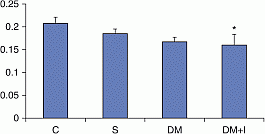ECE2013 Poster Presentations Diabetes (151 abstracts)
Copeptin: may it be a novel biomarker for insulin theraphy in subjects with diabetes?
Ece Harman 1 , Yavuz Dodurga 2 , Gulsah Gundogdu 3 , Ceylan Ayada 4 , Gulten Erken 5 , Vural Kucukatay 3 , Cigir Biray Avci 6 & Osman Genc 4
1Department of Endocrinology, Ataturk Training and Research Hospital, Izmir Katip Celebi University, Izmir, Turkey; 2Department of Medical Biology, Pamukkale University School of Medicine, Denizli, Turkey; 3Department of Physiology, Pamukkale University School of Medicine, Denizli, Turkey; 4Department of Physiology, Dumlupinar University School of Medicine, Kutahya, Turkey; 5Department of Physiology, Balikesir University School of Medicine, Balikesir, Turkey; 6Department of Medical Biology, EgeUniversity School of Medicine, Izmir, Turkey.
Background and aim: As a prognostic marker, copeptin levels were independent predictors of survival in critically ill patients suffering from hemorrhagic and septic shock. Copeptin levels also have prognostic implications in chronic diseases other than acute illness. The stress-mediated activation of the HPA axis may be have role in the pathogenesis of the insulin resistance, metabolic syndrome, and diabetes. Furthermore, AVP action has been linked to liver glycogenolysis and insulin and glucagon secretion. We tested the hypothesis that plasma copeptin would be associated with stress, diabetes, and treatment of diabetes.
Materials and methods: Healthy male Wistar rats, about 3 months old, weighing 200–250 g, were obtained from University Animal House. They were housed in small cages at standard conditions (24±2 °C and 50±5% humidity) with a 12 h light:12 h darkness cycle and were fed ad libitum with standard rat chow and tap water. Rats were divided into four groups: eight control (C), eight diabetic (D), eight diabetic+ insulin (DI) and eight stress (S) rats. Blood samples were collected into plain tubes (1.5 ml) and serum was separated via centrifugation at 1500 r.p.m. for 15 min. Samples were stored at −86 °C until analysis. Quantitative measurement of copeptin was performed using the ELISA method (Uscn Life Sciences, USA), according to the manufacturer’s instructions.
All values are expressed as the mean±S.D.. The data were evaluated by one-way ANOVA and post hoc least significant difference (LSD) for multiple comparisons of the means. P values <0.05 were considered significant.
Results: There was not significant difference in terms of serum copeptin levels among groups except diabetes+insulin group.
Conclusions: Copeptin may be considered as a new tool for the comparison of the efficiencies of new therapeutic modalities in diabetes.

Figure 1 ELISA results of copeptin. C, control; S, stress; DM, diabetes mellitus; DM+I, diabetes mellitus+ insulin; *P<0.05.
 }
}



